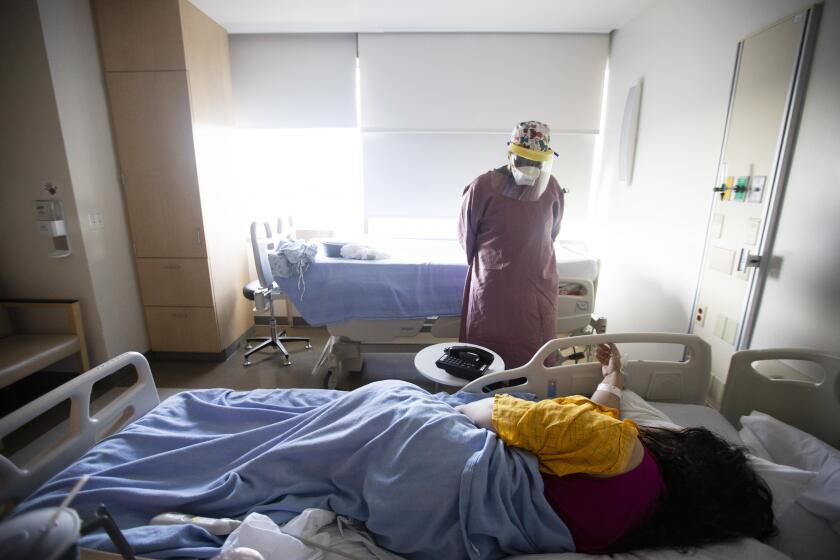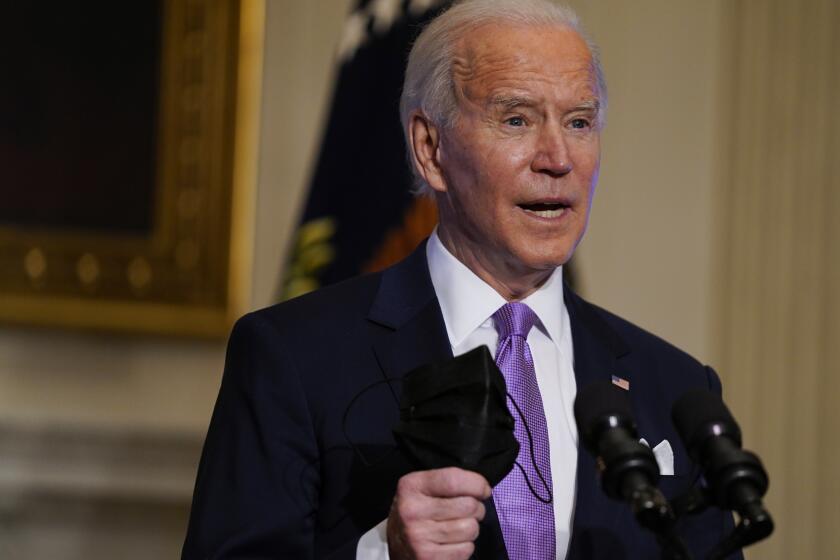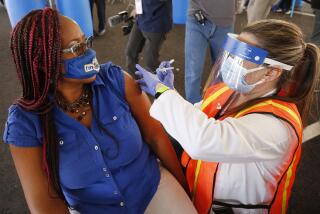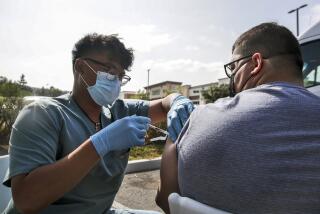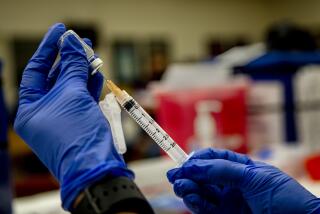Growing racial inequities in L.A. County vaccine rollout raise alarms
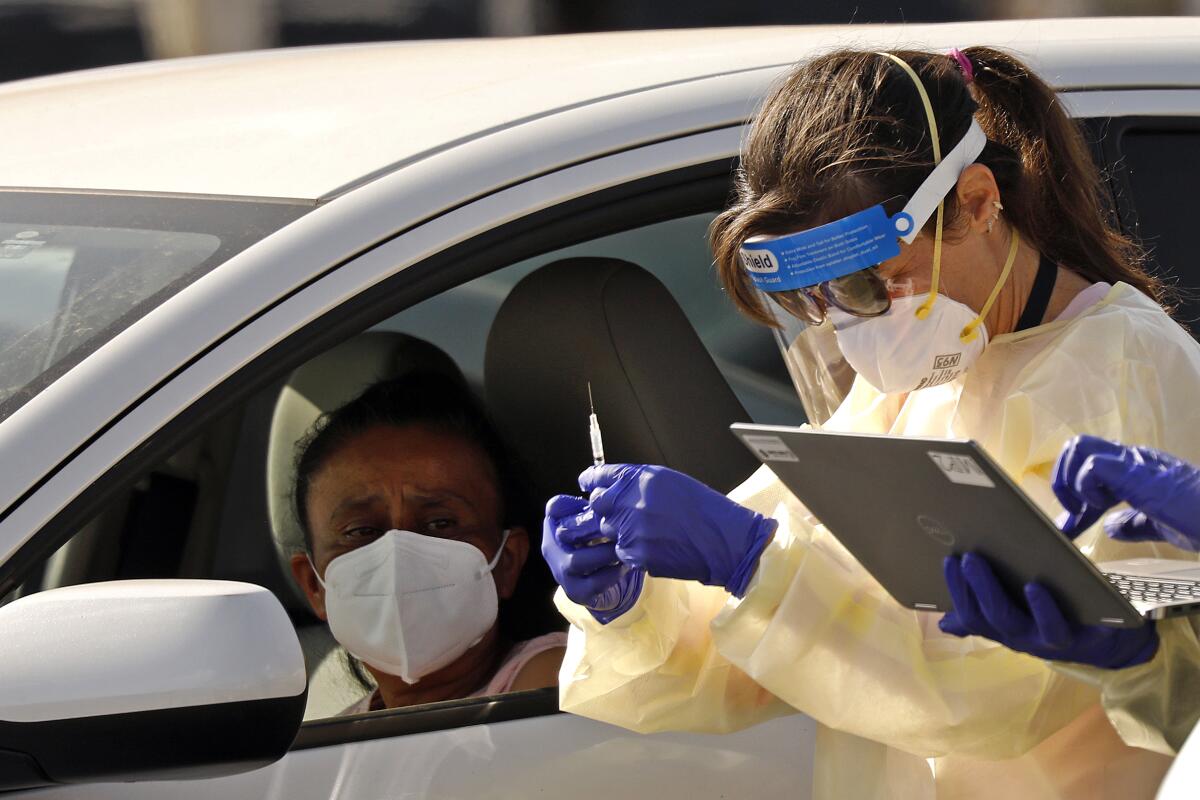
- Share via
Just weeks into California’s rocky rollout of the coronavirus vaccine, evidence is emerging of inequities in who is getting the medicine, prompting growing demands that vulnerable communities receive more attention.
Los Angeles County officials said they are concerned about low vaccination numbers among healthcare workers in South L.A. and other communities of color, while advocates for essential workers worry that California’s new vaccine priority plan slows their ability to get inoculated despite the dangers inherent in their jobs.
The county Department of Public Health released demographic data Tuesday showing a significantly lower rate of vaccinations for healthcare workers who live in South L.A., home to large populations of Black and Latino residents, compared with other regions.
Public Health Director Barbara Ferrer told the Board of Supervisors that her agency was “particularly concerned” about the low vaccination rate among healthcare workers living in South L.A. In response, the county will open six vaccination sites there, including at the outpatient center at Martin Luther King Jr. Community Hospital, St. John’s Well Child & Family Center and three Rite Aid pharmacies.
“There may be many issues that contribute to the lower vaccination rates that we’re seeing in some communities, but the one issue that we don’t want to have accounting for a lower vaccination rate is that there wasn’t good access to places for people to get vaccinated,” Ferrer said.
The data presented did not include vaccinations given by the Pasadena and Long Beach health departments, by Walgreens or CVS, or by large health systems, including Kaiser Permanente. But it showed the number of doses given to workers who live on the Westside, the west San Fernando Valley, the South Bay and parts of the San Gabriel Valley were relatively higher than in South L.A.
Experts say about most Americans will need to be vaccinated to bring the coronavirus pandemic under control. Track California’s progress toward that goal.
But even with the incomplete snapshot, Supervisor Hilda Solis said it was clear there was a disparity among Black healthcare workers who’ve been vaccinated compared with other racial groups. She said the rates among Native American residents and Latinos were also far too low.
“I know there’s large numbers of other populations that are getting the vaccine at higher rates than others, and I would just ask: What are we going to do?” Solis said.
Among the county’s healthcare workforce, Black employees requested to be vaccinated at far lower rates than any other racial or ethnic group, another concerning trend.
Among just over 4,000 Black employees, just under one-third have received the vaccine. More than half have not requested it, according to Department of Health Services data.
Other racial and ethnic groups are seeing much higher rates of vaccination.
Among 7,500 Latino healthcare employees at the county Department of Health Services, about half have received the COVID-19 vaccine and an additional 15% have requested it. The majority of Asian American and white employees have also either received or requested the vaccine.
Dr. Christina Ghaly, the agency’s director, said it’s a trend seen not just among the county’s healthcare staff but also at private hospitals and clinics in L.A. County.
Black employees have said they didn’t get vaccinated because they still had a lot of questions about the vaccine, such as whether it can cause COVID-19, she said. (It cannot; the vaccine does not include the coronavirus.)
Only 32% of Black adults say they would take a COVID-19 vaccine. That speaks volumes about the need for a reckoning on racism in healthcare and building trust in the communities hit hardest by the pandemic.
Ferrer said some people would rather wait a while before getting the vaccine until they see other people get it, and she said that’s OK.
“We do feel very confident that the data at hand says it’s very safe and effective,” Ferrer said.
Experts have long expected that vaccine hesitancy would be an issue, including among those who have dealt with long-standing, systemic racism in the healthcare system, fueling mistrust in some communities.
Just 32% of Black adults nationwide say they would definitely or probably take a COVID-19 vaccine, according to the Pew Research Center.
“We have a long history in this country and other countries that make it difficult for people to trust some of the medical advances that we’re promoting,” Ferrer said.
The inequities come amid growing debate over the state’s rollout plans. Vaccine remains in short supply and appointment slots have reportedly filled up at sites across the state. To date, more than 2.5 million doses have been administered statewide and more than 4.6 million doses have been shipped to local health departments and providers.
Gov. Gavin Newsom’s announcement Monday that the state would begin giving vaccination priority to people based on their age has sparked concerns from groups representing some essential workers and disabled people who may now have to wait longer.
Before Newsom’s announcement, the state intended to give priority to several new groups after California is done vaccinating people 65 and older, including residents in incarcerated and homeless settings, essential workers and individuals with underlying health conditions.
It’s now unclear when those groups would be vaccinated.
Officials said California will implement a statewide eligibility standard starting in mid-February — allowing those who work in the education and child-care, emergency services and agriculture and food sector to begin making vaccine appointments pending availability. Healthcare workers and those older than 65 would also remain a priority.
“Californians were understandably confused by mixed messages, variability of eligibility across the state, ‘When it’s my turn, who’s going next?’” Yolanda Richardson, secretary of the state’s Government Operations Agency, said during a briefing Tuesday.
A more uniform framework, she said, “will make it easier for Californians to understand who is eligible to make an appointment to get vaccinated.”
State officials insist that equity remains a key factor in how the vaccine is being rolled out.
“We don’t want to have equity and speed at odds to one another,” added Dr. Mark Ghaly, California’s health and human services secretary. “It’s an important equity principle to get those who are disproportionately impacted vaccine [doses] quickly.”
Part of that equation, he said during a briefing Tuesday, is “ensuring that we have real-time data” to assess whether those efforts are paying off, and to make adjustments if necessary.
A slide he presented offered some additional considerations — that “vaccines will be allocated to make sure low-income neighborhoods and communities of color will have access” and that “providers will be compensated in part by how well they are able to reach underserved communities.”
Mark Ghaly said “the worst thing is when people don’t know where they are in the line” and that, in adjusting its processes, the state is “listening to a lot of feedback, making what I would say are difficult decisions, but trying to make sure that they’re clear and simple to follow.”
“Using an age-based framework helps us get there,” he said.
Not everyone agrees.
A coalition of more than 60 community organizations on Tuesday urged Newsom to reconsider.
President Biden announces additional steps to boost the federal government’s role in addressing the troubled rollout of vaccines in the United States.
The new approach would leave hundreds of thousands of low-wage workers, inmates and homeless individuals vulnerable to the deadly virus, said Najee Ali, a South L.A. activist and part of the Community Response System of South Los Angeles coalition.
“It’s a life-or-death situation for Black and Latino essential workers,” he said.
County Supervisor Holly Mitchell said she worries the state is moving toward a vaccine distribution framework that may not “address what is really necessary to deliver a really equitable and ethical vaccine program when you look at communities that are being disproportionately hit by the virus.”
Mitchell noted that Latino residents in L.A. County are dying of COVID-19 at triple the rate of white residents, and the COVID-19 death rate among people living in the most impoverished neighborhoods of L.A. County are almost four times the rate of residents in the wealthiest areas.
“If our ultimate goal is to reduce infections, hospitalization and mortality rates, we’ve got to figure out how to target those who are truly at most risk,” Mitchell said.
Advocates for the disabled are also worried about being left out of the criteria.
“It sounds like it’s more bad news for people with disabilities,” Andy Imparato of Disability Rights California said following Mark Ghaly’s briefing. “They mentioned race and marginalized populations, but didn’t mention people with disabilities.”
Solis said some L.A. County residents have traveled far to get their vaccines. On Friday, Solis said more than 100 seniors received their first dose at L.A. County-USC Medical Center in Boyle Heights.
“I met an 82-year-old woman in line, pushing her son who uses a wheelchair ... and I was so in awe of her resilience,” Solis said. One 67-year-old man took three buses from South Gate to get the shot before heading to his restaurant job in Downey.
Solis asked why he came, and he responded: “Because it’s a matter of my life, and also providing for my family.”
Times staff writer Erika D. Smith contributed to this report.
More to Read
Sign up for Essential California
The most important California stories and recommendations in your inbox every morning.
You may occasionally receive promotional content from the Los Angeles Times.

